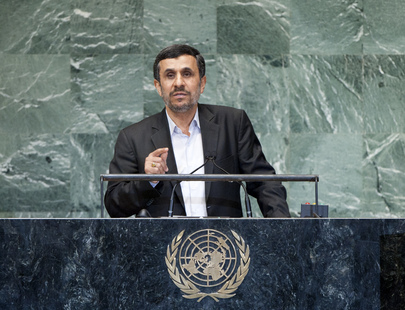
Image Credit: United Nations webtv.un.org
Almost every male speaker to the September Summit of the General Assembly of the United Nations wore a suit and tie. It is easy to overlook this fact, so widespread is the convention, so rare the defiance. But what heads of state wear in front of one another shows something peculiar about the modern nation state. Leaders are, by and large, drawn from the cultural and economic elite. What all this suit-and-tie wearing indicates, however, is that the ruling class of the modern nation-state must subscribe, or seem to subscribe, to middle class or “business” virtues, like hard work, entrepreneurship, merit, and self-effacement. When a male leader chooses not to don a suit and tie, a choice made by President of Iran Mahmoud Ahmadinejad (pictured above), he is really saying something: but what, exactly, is he saying?
Take, for example, the suit and tie worn by U.S. President Barack Obama for his address to the world on September 25.
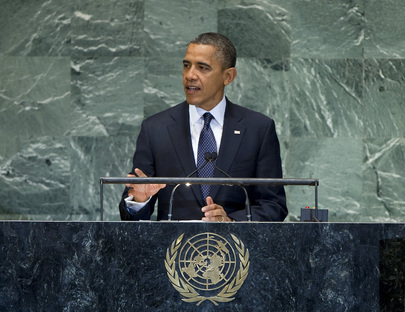
Image Credit: United Nations webtv.un.org
President Obama's suit does not strike me as ostentatious; stylistically, it does not depart from the appearance of workaday, professional attire. (Note, however, how neatly tailored and solidly constructed the clothes are. Not every workaday businessman can afford such a suit!)
Let us take President Obama as the rule and President Ahmadinejad as the exception that proves the rule. Now, what was the historical process by which suit-wearing became the standard for heads of state? Let us speculate.
I would argue that to arrive at an answer which would explain both Ahmadinejad's and Obama's sartorial selections, we need to describe two interelated historical processes, one pertaining to the imperialist nation-states of the Nineteenth Century, the other to the nation-states formed through decolonization in the Nineteenth and Twentieth Centuries.
Of first importance, in the imperialist case, was the long process by which the traditional power formations of the aristocracies--based on tradition, heredity wealth and landholding--were transformed into power formations of the monied classes. This transition was no neat break, including as it did, urbanization and industrialization, the rise of literacy and the popular press, the networking of global cities through shipping, railroad, mail and telegram, the increasing importance of credit to the state, the ousting from parliamentary structures of “gentlemen” by lawyers, bankers, and labor-leaders; in a word, everything (and it’s a lot) that comes as money plays more and more the determining role in social ascendancy. It was a complex historical process inflected by place and contingency; but roughly speaking, the ruling class was kings and barons and lords, and then it became businessmen and buerocratic professionals. The leaders of today's "super-power" nations wear suits, and that includes China, as instanced by Premiere Wen Jiabao (pictured below):

Image Credit: United Nations webtv.un.org
As for the male leaders of decolonized nation-states, I speculate that they wear suits-and-ties as the price of entry, as it were, into "respectable" standing at the United Nations. In a word, wearing a suit-and-tie is a matter of hegemony.
Inflecting these large, world-historical processes--the ascendance of middle-class hegemony as it played out in the West and in the era of decolonization--are other factors, including culture and gender. For of course, not every head of state or person of power wears a suit to the UN. Sometimes the choice of garb would appear to reflect culture of origin, as in the case of Lyonchoen Jigmi Yoezer Thinley, Prime Minister of the Kingdom of Bhutan (pictured below).

Image Credit: UN webtv.un.org
The military dictators wear uniforms. Many of the women wear the female equivalent of the suit-and-tie, as instanced by Dessima Williams, Permanent Representative of Grenada to the UN:
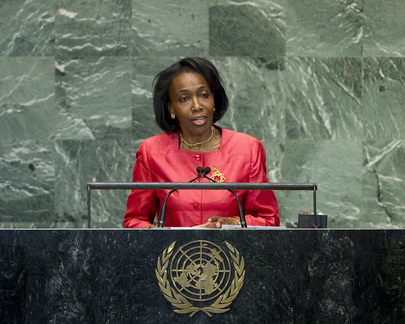
Image Credit: UN webtv.un.org
And, of course, to really explain why a person wears a particular article of clothing to the General Assembly we would have to tell add the histories by which "female suits" or military uniforms became available as options but also personal and family histories and psychologies, contemporary networks of clothes production and consumption, and maybe even a little randomness.
But accounting for all the different variations on suits and the military dictators and the cultural-garb--each of which could bear more analysis--there remains a specific kind of outlier, and that is the person who references the suit while flaunting its conventions. It is these I would point your attention to; these are the ones dressing to dissent, these are the leaders who are highlighting a difference from the world-hegemony that says modern leaders are business people (if they are not military dictators).
Ahmadinejad wears no tie in front of the UN, and the reason is historical and ideological, just as I have posited: according to the BBC and the Guardian, Iran banned the sale of ties after the 1979 Islamlic Revolution in order to signal non-alliance with the West.
Dressing to dissent at the UN, by my analysis, requires gesturing towards the suit-and-tie but flaunting its conventions. President of Venezuela Hugo Chavez achieves this not by foregoing the tie but through tie selection:
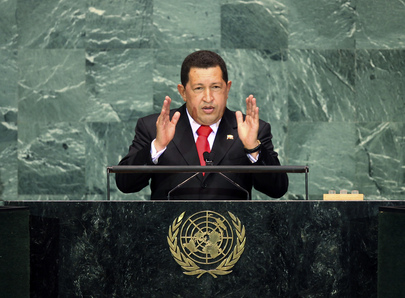
Image Credit: UN webtv.un.org
Chavez's bright, broad red tie is no business man's: it is a flaunt at the "leaders-are-professionals" hegemony of the United Nations.
Let us conclude with a final instance that stretches my theory. Pictured below is the late Noble Prize Winner Wangari Muta Maathai, founder of the Greenbelt Movement in Kenya, a non-violent protester and person of great influence. (There is a very moving Independent Lens documentary about this incredible person entitled "Taking Root.")
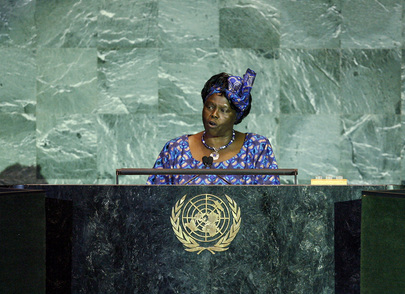
Image Credit: UN webtv.un.org
Wangari Muta Maathai is wearing a dress not professional women's garb. Nor does it seem to me her clothing decision can be explained away as an innocuous gesture towards culture of origin, as can the King of Bhutan's. No, I think Wangari Muta Maathai is dressing to dissent in this instance, tactically using culture and gender to do so but without falling into the "exotic performance of culture/gender" that brings into hegemonic alliance other non-suit wearers. This is a tricky feat, and it is difficult to put a finger on just how she manages it. Nevertheless, it forms an additional option to flaunting-the-suit for those who wish to perform resistance to the hierarchies of the UN and indeed the world.







Recent comments
2 years 29 weeks ago
2 years 44 weeks ago
2 years 44 weeks ago
2 years 50 weeks ago
3 years 4 weeks ago
3 years 4 weeks ago
3 years 4 weeks ago
3 years 6 weeks ago
3 years 6 weeks ago
3 years 6 weeks ago